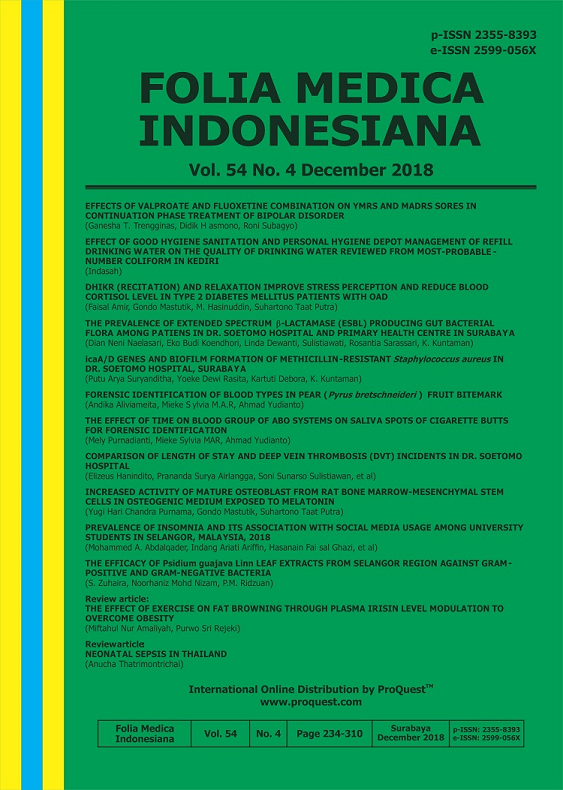Main Article Content
Abstract
Keywords
Article Details
-
Folia Medica Indonesiana is a scientific peer-reviewed article which freely available to be accessed, downloaded, and used for research purposes. Folia Medica Indonesiana (p-ISSN: 2541-1012; e-ISSN: 2528-2018) is licensed under a Creative Commons Attribution 4.0 International License. Manuscripts submitted to Folia Medica Indonesiana are published under the terms of the Creative Commons License. The terms of the license are:
Attribution ” You must give appropriate credit, provide a link to the license, and indicate if changes were made. You may do so in any reasonable manner, but not in any way that suggests the licensor endorses you or your use.
NonCommercial ” You may not use the material for commercial purposes.
ShareAlike ” If you remix, transform, or build upon the material, you must distribute your contributions under the same license as the original.
No additional restrictions ” You may not apply legal terms or technological measures that legally restrict others from doing anything the license permits.
You are free to :
Share ” copy and redistribute the material in any medium or format.
Adapt ” remix, transform, and build upon the material.

References
- Abdelrahim SI, Almagboul AZ, Omer ME, Elegami A (2002). Antimicrobial activity of Psidium guajava Linn. Fitoterapia 73, 713-715
- Brain KR, Turner TD (1975). The practical evaluation of phytopharmaceuticals Wright-scientechnica Bristol, 4-9, 60, 76-79
- Ciulei I (1994). Methodology for the analysis of vegetable drugs, chemical industries branch. Division of Industrial operations. Romania, UNID O, p 21-97
- Cohen ML (1992). Epidemiology of drug resistance: Implications for a post-antimicrobial era. New York, Science , p 257
- Dixon RA, Dey PM, Lamb CJ (1983). Phytoalexins: Enzymology and molecular biology. Advances in Enzymology and Related Areas of Molecular Biology 55, 1-136
- Duh PD, Tu YY, Yen GC (1999). Antioxidant Activity of Water Extract of Harng Jyur (Chrysanthemum morifolium Ramat). LWT - Food Science and Technology 32, 269-277
- Farnsworth NR (1993). Ethno pharmacology and future drug development: The North American experience. J Ethnopharmacol 38, 145-52
- Gnan SO, Demello MT (1999). Inhibition of Staphylococcus aureus by aqueous goiba extracts. J. Ethnopharm 68, 103-108
- Hancock EW (2005). Mechanisms of action of newer antibiotics for Gram-positive pathogens. Lancet Infect. Dis 5, 209-218
- Levy SB, Marshall B (2004). Antibacterial resistance worldwide: causes, challenges and responses. Nature Medicine 10, S122-S129
- Pietta PG (2000). Flavonoids as antioxidants. J Nat Prod 63, 1035-42
- Rice-evans CA, Miller NJ, Bolwell PG, Bramley PM, Pridham JB (1995) The relative antioxidant activities of plant-derived polyphenolic flavonoids. Free Radical Research 22, 375-383
- Ruban P, Gajalakshmi K (2012). In vitro antibacterial activity of Hibiscus rosa-sinensis flower extract against human pathogens. Asian Pac J Trop Biomed 2, 399-403
- Sofowora AA (1993). Medicinal plants and Traditional medicines in Africa 2nd edition. Ibadan, Spectrum Books Ltd, p 81-85
- Tsuchiya H, Sato M, Miyazaki T (1996) Comparative study on the antibacterial activity of phytochemical flavanones against methicillin-resistant Staphylococcus aureus. Journal of Ethnopharmacology 50, 27-34
- Wilson GP (2001), Myrtaceae revised: A reassessment of infrafamilial groups. American Journal of Botany 88, 2013-2025
- World Health Organization (WHO) (2002). Antimicrobial resistance. Bristol, Fact sheet No. 194m Wright Scientechiea, p 57-58
References
Abdelrahim SI, Almagboul AZ, Omer ME, Elegami A (2002). Antimicrobial activity of Psidium guajava Linn. Fitoterapia 73, 713-715
Brain KR, Turner TD (1975). The practical evaluation of phytopharmaceuticals Wright-scientechnica Bristol, 4-9, 60, 76-79
Ciulei I (1994). Methodology for the analysis of vegetable drugs, chemical industries branch. Division of Industrial operations. Romania, UNID O, p 21-97
Cohen ML (1992). Epidemiology of drug resistance: Implications for a post-antimicrobial era. New York, Science , p 257
Dixon RA, Dey PM, Lamb CJ (1983). Phytoalexins: Enzymology and molecular biology. Advances in Enzymology and Related Areas of Molecular Biology 55, 1-136
Duh PD, Tu YY, Yen GC (1999). Antioxidant Activity of Water Extract of Harng Jyur (Chrysanthemum morifolium Ramat). LWT - Food Science and Technology 32, 269-277
Farnsworth NR (1993). Ethno pharmacology and future drug development: The North American experience. J Ethnopharmacol 38, 145-52
Gnan SO, Demello MT (1999). Inhibition of Staphylococcus aureus by aqueous goiba extracts. J. Ethnopharm 68, 103-108
Hancock EW (2005). Mechanisms of action of newer antibiotics for Gram-positive pathogens. Lancet Infect. Dis 5, 209-218
Levy SB, Marshall B (2004). Antibacterial resistance worldwide: causes, challenges and responses. Nature Medicine 10, S122-S129
Pietta PG (2000). Flavonoids as antioxidants. J Nat Prod 63, 1035-42
Rice-evans CA, Miller NJ, Bolwell PG, Bramley PM, Pridham JB (1995) The relative antioxidant activities of plant-derived polyphenolic flavonoids. Free Radical Research 22, 375-383
Ruban P, Gajalakshmi K (2012). In vitro antibacterial activity of Hibiscus rosa-sinensis flower extract against human pathogens. Asian Pac J Trop Biomed 2, 399-403
Sofowora AA (1993). Medicinal plants and Traditional medicines in Africa 2nd edition. Ibadan, Spectrum Books Ltd, p 81-85
Tsuchiya H, Sato M, Miyazaki T (1996) Comparative study on the antibacterial activity of phytochemical flavanones against methicillin-resistant Staphylococcus aureus. Journal of Ethnopharmacology 50, 27-34
Wilson GP (2001), Myrtaceae revised: A reassessment of infrafamilial groups. American Journal of Botany 88, 2013-2025
World Health Organization (WHO) (2002). Antimicrobial resistance. Bristol, Fact sheet No. 194m Wright Scientechiea, p 57-58

